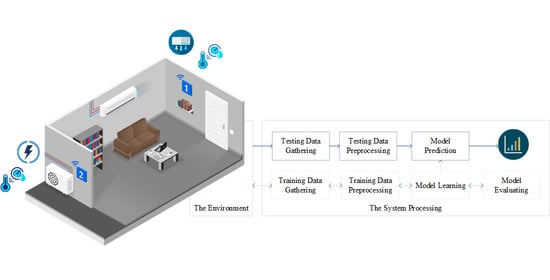Deep Learning-Driven Automated Fault Detection and Diagnostics Based on a Contextual Environment: A Case Study of HVAC System
Abstract
1. Introduction
- To determine how AFDD employs contextual factors to support indirect measurement;
- To design and develop a DL-based AFDD model in the context of HVAC systems;
- To prove that the DL-based AFDD model based on contextual factors is suitable for HVAC systems.
2. Background Knowledge and Related Works
2.1. Human-like Intelligence and AFDD
2.2. Context Observation Based on the Internet of Things
2.3. Building Engineering, Contextual Factors, and Deep Learning
3. Fault Events and Contextual Factors
4. Contextual-Based Deep Learning Framework
4.1. Overview Architecture of Proposed System
4.2. Deep Learning
4.3. The Deep Learning Model Development
5. Experimental Setup
5.1. Experimental Objectives
5.2. Model Testing Metrics
5.3. Dataset Description
5.4. Results and Discussions
6. Conclusions
Author Contributions
Funding
Institutional Review Board Statement
Informed Consent Statement
Data Availability Statement
Conflicts of Interest
References
- Song, Y.; Mao, F.; Liu, Q. Human Comfort in Indoor Environment: A Review on Assessment Criteria, Data Collection and Data Analysis Methods. IEEE Access 2019, 7, 119774–119786. [Google Scholar] [CrossRef]
- Tsang, T.W.; Mui, K.W.; Wong, L.T. Investigation of thermal comfort in sleeping environment and its association with sleep quality. Build. Environ. 2021, 187, 107406. [Google Scholar] [CrossRef]
- Cao, T.; Lian, Z.; Ma, S.; Bao, J. Thermal comfort and sleep quality under temperature, relative humidity and illuminance in sleep environment. J. Build. Eng. 2021, 43, 102575. [Google Scholar] [CrossRef]
- Shrestha, M.; Rijal, H.B.; Kayo, G.; Shukuya, M. A field investigation on adaptive thermal comfort in school buildings in the temperate climatic region of Nepal. Build. Environ. 2021, 190, 107523. [Google Scholar] [CrossRef]
- Guevara, G.; Soriano, G.; Mino-Rodriguez, I. Thermal comfort in university classrooms: An experimental study in the tropics. Build. Environ. 2021, 187, 107430. [Google Scholar] [CrossRef]
- Shi, Z.; O’Brien, W. Development and implementation of automated fault detection and diagnostics for building systems: A review. Autom. Constr. 2019, 104, 215–229. [Google Scholar] [CrossRef]
- Zhao, P.; Zheng, Q.; Ding, Z.; Zhang, Y.; Wang, H.; Yang, Y.A.; Ragulskis, M.; Cao, M.; Zimroz, R.; Fakher, C.; et al. A High-Dimensional and Small-Sample Submersible Fault Detection Method Based on Feature Selection and Data Augmentation. Sensors 2021, 22, 204. [Google Scholar] [CrossRef]
- Rafati, A.; Shaker, H.R.; Ghahghahzadeh, S. Fault Detection and Efficiency Assessment for HVAC Systems Using Non-Intrusive Load Monitoring: A Review. Energies 2022, 15, 341. [Google Scholar] [CrossRef]
- Iannace, G.; Ciaburro, G.; Trematerra, A. Heating, ventilation, and air conditioning (HVAC) noise detection in open-plan offices using recursive partitioning. Buildings 2018, 8, 169. [Google Scholar] [CrossRef]
- Shi, Q.; Liu, C.; Xiao, C. Machine learning in building energy management: A critical review and future directions. Front. Eng. Manag. 2022, 9, 239–256. [Google Scholar] [CrossRef]
- Vukovi´c, M.V.; Thalmann, S. Causal Discovery in Manufacturing: A Structured Literature Review. J. Manuf. Mater. Process. 2022, 6, 10. [Google Scholar] [CrossRef]
- Valinejadshoubi, M.; Moselhi, O.; Bagchi, A.; Salem, A. Development of an IoT and BIM-based automated alert system for thermal comfort monitoring in buildings. Sustain. Cities Soc. 2021, 66, 102602. [Google Scholar] [CrossRef]
- Karthick, T.; Charles Raja, S.; Jeslin Drusila Nesamalar, J.; Chandrasekaran, K. Design of IoT based smart compact energy meter for monitoring and controlling the usage of energy and power quality issues with demand side management for a commercial building. Sustain. Energy Grids Netw. 2021, 26, 100454. [Google Scholar] [CrossRef]
- Moura, P.; Moreno, J.I.; López, G.L.; Alvarez-Campana, M. IoT platform for energy sustainability in university campuses. Sensors 2021, 21, 357. [Google Scholar] [CrossRef]
- Liu, Z.; Xiao, G.; Liu, H.; Wei, H. Multi-Sensor Measurement and Data Fusion. IEEE Instrum. Meas. Mag. 2022, 25, 28–36. [Google Scholar] [CrossRef]
- Yang, C.; Gunay, B.; Shi, Z.; Shen, W. Machine Learning-Based Prognostics for Central Heating and Cooling Plant Equipment Health Monitoring. IEEE Trans. Autom. Sci. Eng. 2021, 18, 346–355. [Google Scholar] [CrossRef]
- Yun, W.S.; Hong, W.H.; Seo, H. A data-driven fault detection and diagnosis scheme for air handling units in building HVAC systems considering undefined states. J. Build. Eng. 2021, 35, 102111. [Google Scholar] [CrossRef]
- Xiao, Z.; Gang, W.; Yuan, J.; Chen, Z.; Li, J.; Wang, X.; Feng, X. Impacts of data preprocessing and selection on energy consumption prediction model of HVAC systems based on deep learning. Energy Build. 2022, 258, 111832. [Google Scholar] [CrossRef]
- Wei, S.; Tien, P.W.; Wu, Y.; Calautit, J.K. A coupled deep learning-based internal heat gains detection and prediction method for energy-efficient office building operation. J. Build. Eng. 2022, 47, 103778. [Google Scholar] [CrossRef]
- Kim, W.; Lee, J.H. Fault detection and diagnostics analysis of air conditioners using virtual sensors. Appl. Therm. Eng. 2021, 191, 116848. [Google Scholar] [CrossRef]
- Ma, N.; Aviv, D.; Guo, H.; Braham, W.W. Measuring the right factors: A review of variables and models for thermal comfort and indoor air quality. Renew. Sustain. Energy Rev. 2021, 135, 110436. [Google Scholar] [CrossRef]
- Sahoh, B.; Kliangkhlao, M.; Kittiphattanabawon, N. Design and Development of Internet of Things-Driven Fault Detection of Indoor Thermal Comfort: HVAC System Problems Case Study. Sensors 2022, 22, 1925. [Google Scholar] [CrossRef] [PubMed]
- Pawar, P.; TarunKumar, M.; Vittal, K.P. An IoT based Intelligent Smart Energy Management System with accurate forecasting and load strategy for renewable generation. Meas. J. Int. Meas. Confed. 2020, 152, 107187. [Google Scholar] [CrossRef]
- Li, G.; Yao, Q.; Hu, Y.; Fang, X.; Wang, L. Investigating thermostat sensor offset impacts on operating performance and thermal comfort of three different HVAC systems in Wuhan, China. Case Stud. Therm. Eng. 2022, 31, 101788. [Google Scholar] [CrossRef]
- Tanasiev, V.; Pluteanu, Ș.; Necula, H.; Pătrașcu, R. Enhancing Monitoring and Control of an HVAC System through IoT. Energies 2022, 15, 924. [Google Scholar] [CrossRef]
- Metwally, E.A.; Farid, A.A.; Ismail, M.R. Development of an IoT assessment method: An interdisciplinary framework for energy efficient buildings. Energy Build. 2022, 254, 111545. [Google Scholar] [CrossRef]
- Vijayan, D.S.; Rose, A.L.; Arvindan, S.; Revathy, J.; Amuthadevi, C. Automation systems in smart buildings: A review. J. Ambient. Intell. Humaniz. Comput. 2020, 1, 1–13. [Google Scholar] [CrossRef]
- Merenda, M.; Porcaro, C.; Iero, D. Edge machine learning for ai-enabled iot devices: A review. Sensors 2020, 20, 2533. [Google Scholar] [CrossRef]
- Li, G.; Zheng, Y.; Liu, J.; Zhou, Z.; Xu, C.; Fang, X.; Yao, Q. An improved stacking ensemble learning-based sensor fault detection method for building energy systems using fault-discrimination information. J. Build. Eng. 2021, 43, 102812. [Google Scholar] [CrossRef]
- Xiong, L.; Yao, Y. Study on an adaptive thermal comfort model with K-nearest-neighbors (KNN) algorithm. Build. Environ. 2021, 202, 108026. [Google Scholar] [CrossRef]
- Qavidel Fard, Z.; Zomorodian, Z.S.; Korsavi, S.S. Application of machine learning in thermal comfort studies: A review of methods, performance and challenges. Energy Build. 2022, 256, 111771. [Google Scholar] [CrossRef]
- Runge, J.; Zmeureanu, R. A Review of Deep Learning Techniques for Forecasting Energy Use in Buildings. Energies 2021, 14, 608. [Google Scholar] [CrossRef]
- Akinosho, T.D.; Oyedele, L.O.; Bilal, M.; Ajayi, A.O.; Delgado, M.D.; Akinade, O.O.; Ahmed, A.A. Deep learning in the construction industry: A review of present status and future innovations. J. Build. Eng. 2020, 32, 101827. [Google Scholar] [CrossRef]
- Ascione, F.; Zhu, H.; Yang, W.; Li, S.; Pang, A. An Effective Fault Detection Method for HVAC Systems Using the LSTM-SVDD Algorithm. Buildings 2022, 12, 246. [Google Scholar] [CrossRef]
- Lee, K.P.; Wu, B.H.; Peng, S.L. Deep-learning-based fault detection and diagnosis of air-handling units. Build. Environ. 2019, 157, 24–33. [Google Scholar] [CrossRef]
- Nguyen, J.L.; Schwartz, J.; Dockery, D.W. The relationship between indoor and outdoor temperature, apparent temperature, relative humidity, and absolute humidity. Indoor Air 2014, 24, 103–112. [Google Scholar] [CrossRef] [PubMed]
- Yin, J.F.; Zheng, Y.F.; Wu, R.J.; Tan, J.G.; Ye, D.X.; Wang, W. An analysis of influential factors on outdoor thermal comfort in summer. Int. J. Biometeorol. 2012, 56, 941–948. [Google Scholar] [CrossRef]
- Bengio, Y. Deep Learning of Representations for Unsupervised and Transfer Learning. In Proceedings of the ICML Workshop on Unsupervised and Transfer Learning, Bellevue, WA, USA, 2 July 2011; pp. 17–37. [Google Scholar]
- Hardt, M.; Recht, B.; Singer, Y. Train faster, generalize better: Stability of stochastic gradient descent. In Proceedings of the 33rd International Conference on Machine Learning, New York, NY, USA, 19–24 June 2016; pp. 1225–1234. [Google Scholar]
- PyTorch: From Research to Production. Available online: https://pytorch.org/ (accessed on 24 October 2022).
- Scikit-Learn Scikit-Learn: Machine Learning in Python. Available online: https://scikit-learn.org/stable/ (accessed on 28 May 2022).
- Cheng, K.; Tao, F.; Zhan, Y.; Li, M.; Li, K. Hierarchical attributes learning for pedestrian re-identification via parallel stochastic gradient descent combined with momentum correction and adaptive learning rate. Neural Comput. Appl. 2020, 32, 5695–5712. [Google Scholar] [CrossRef]
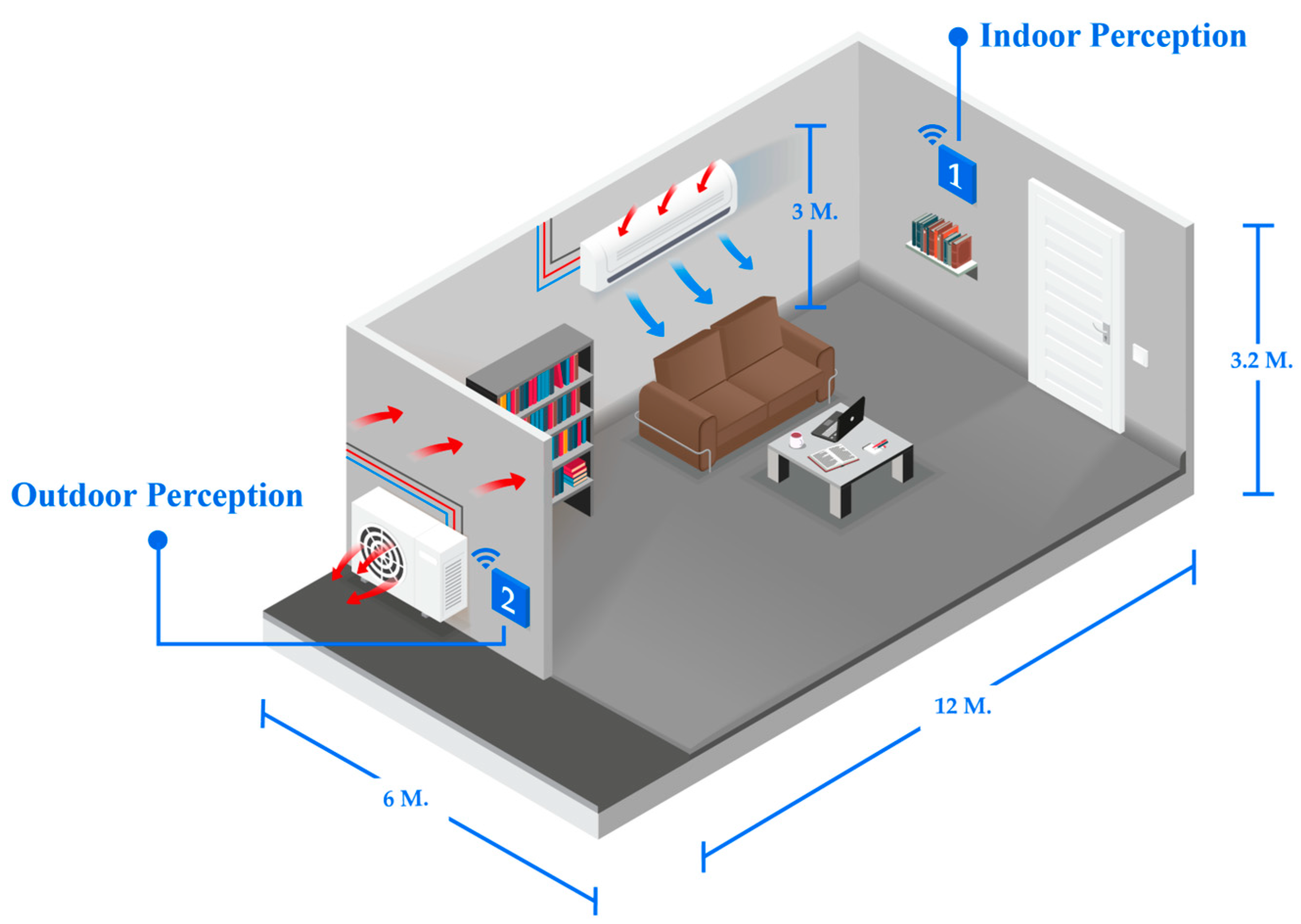

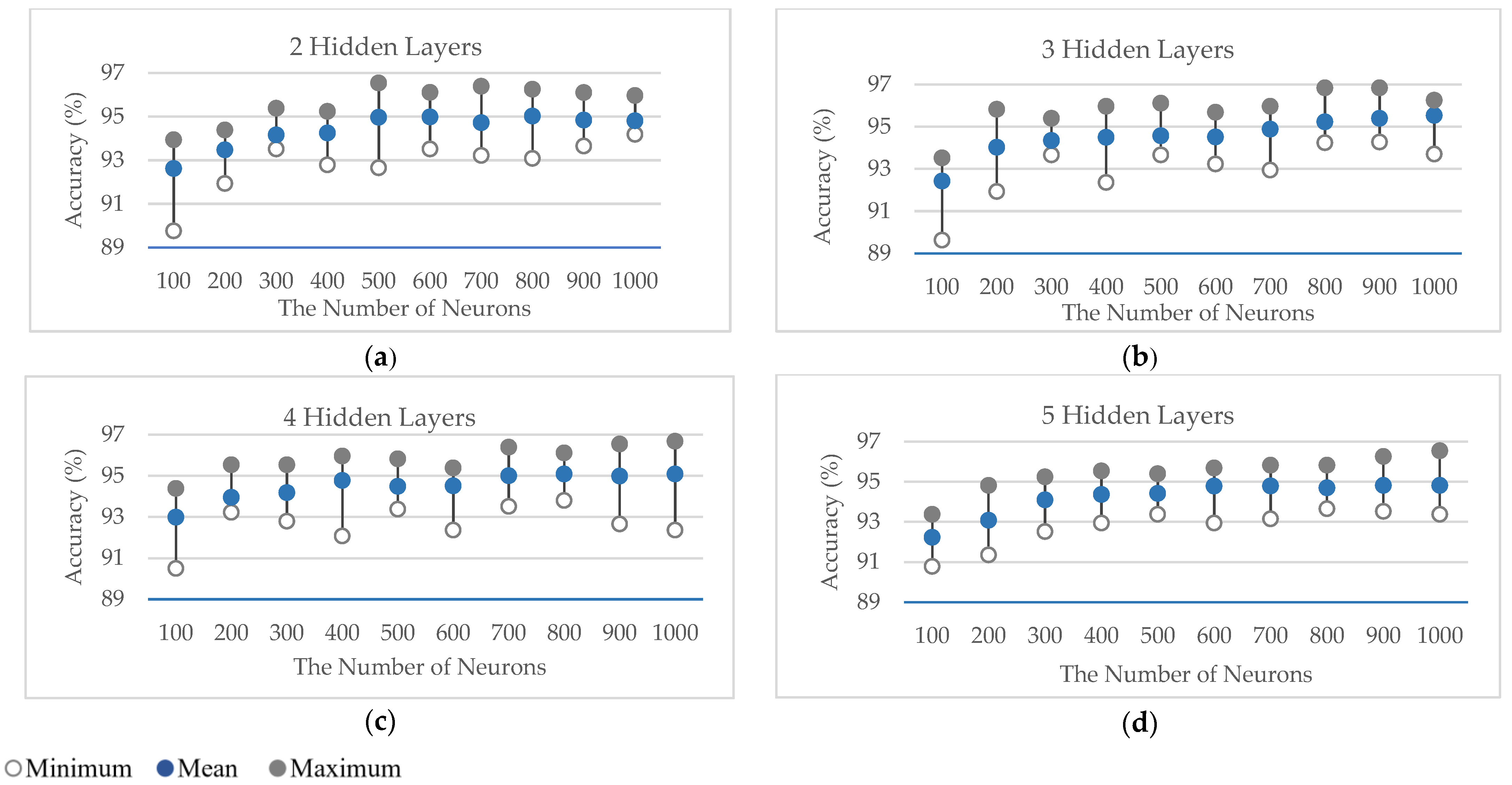
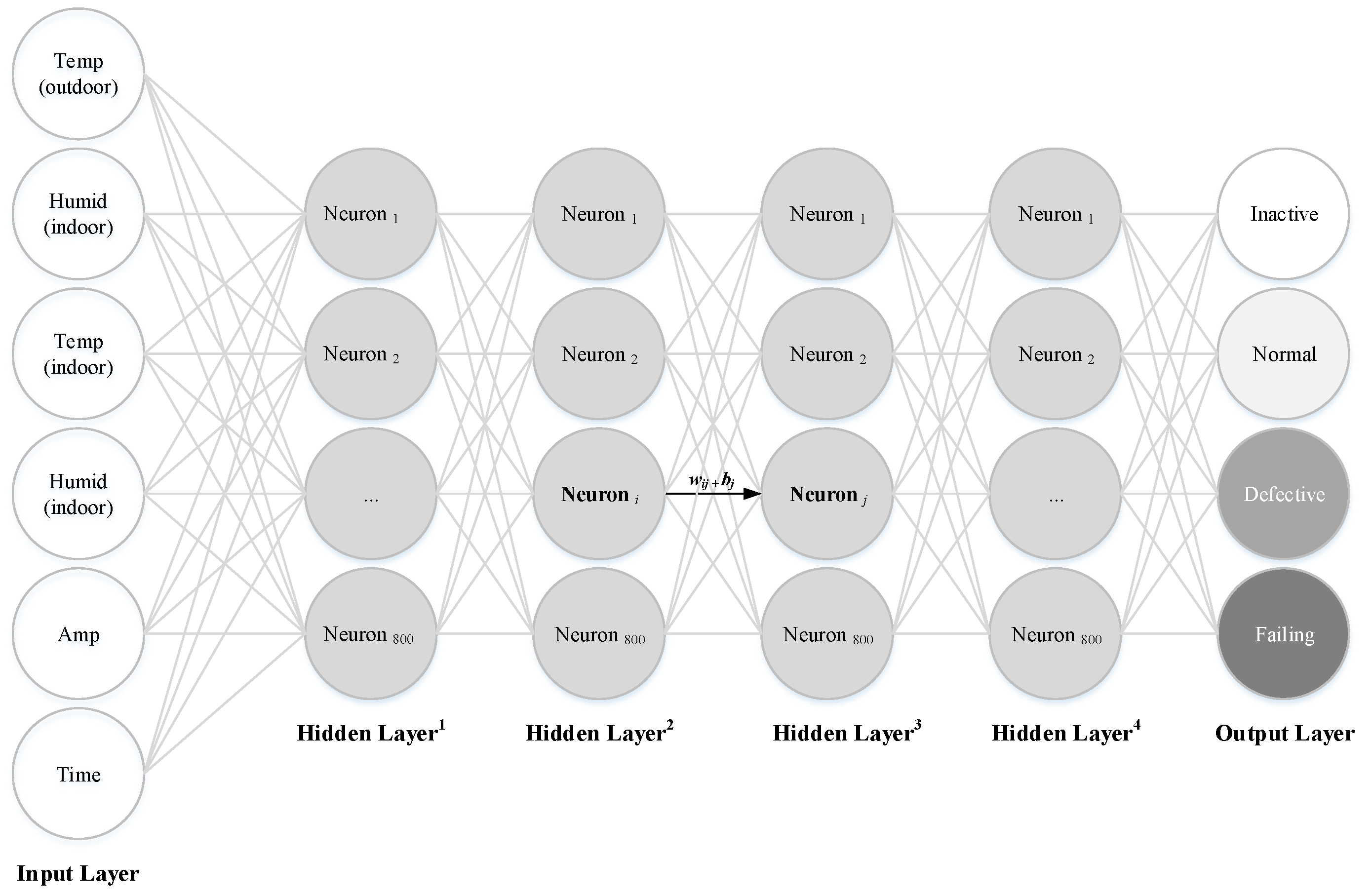
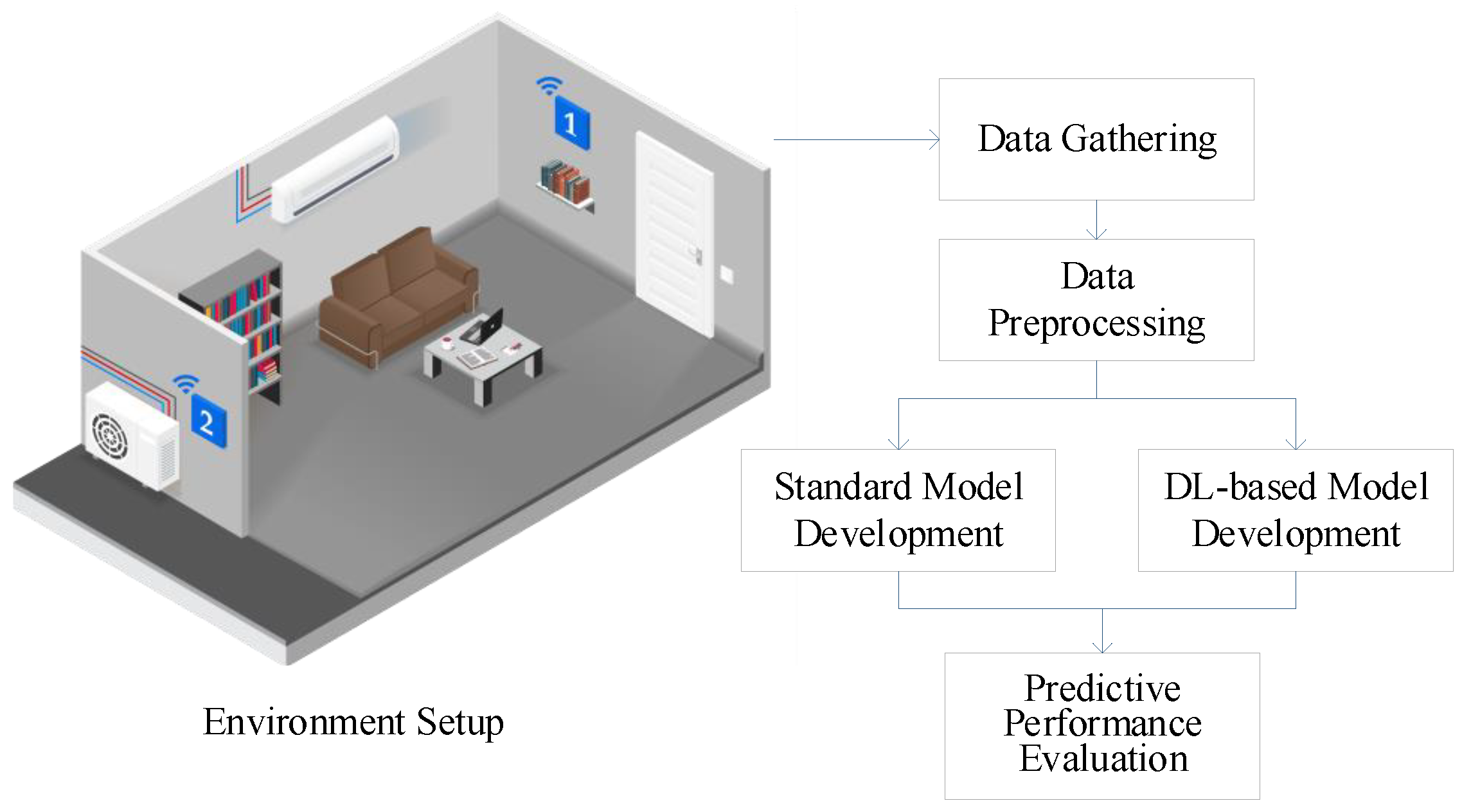
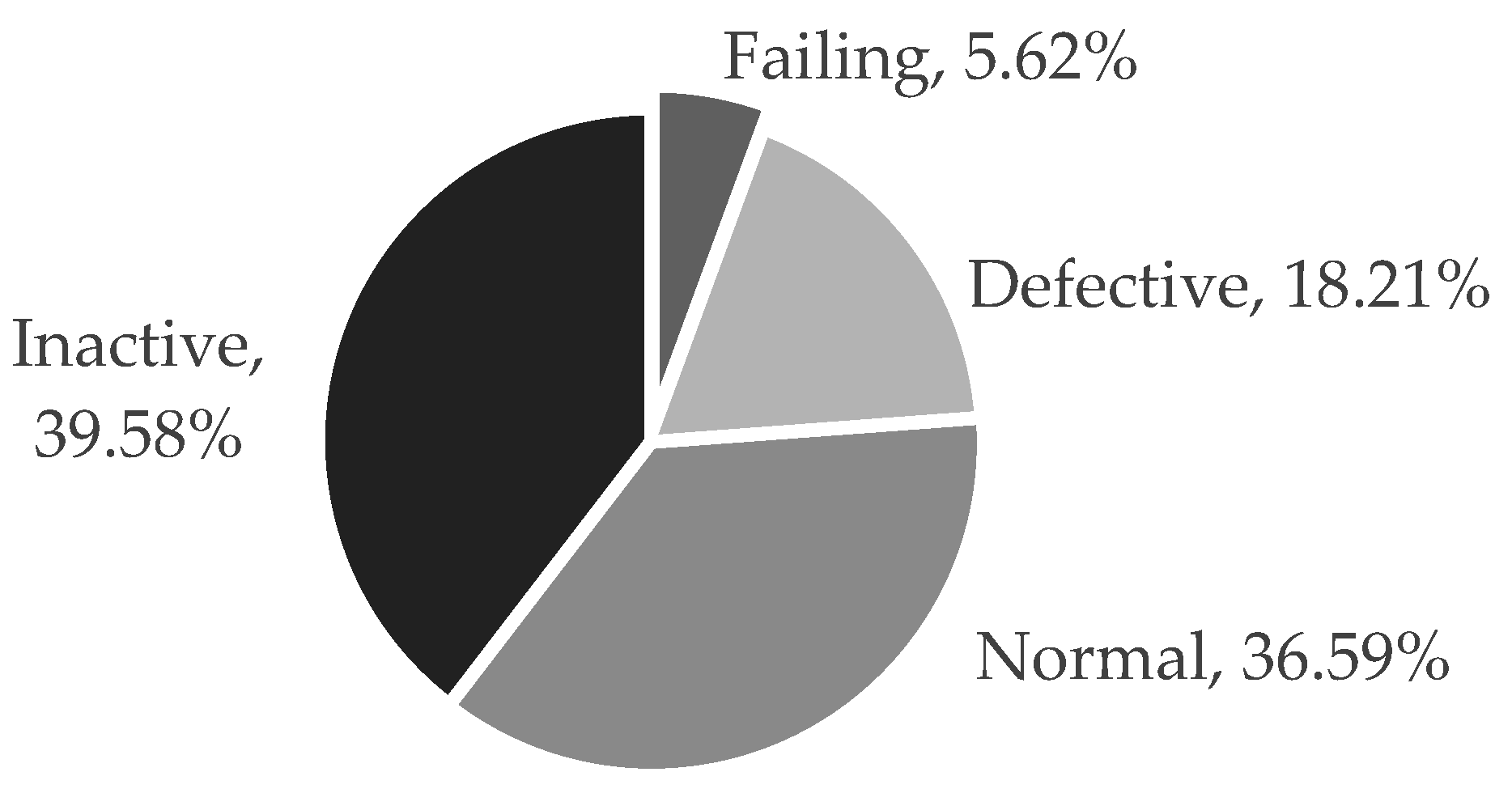
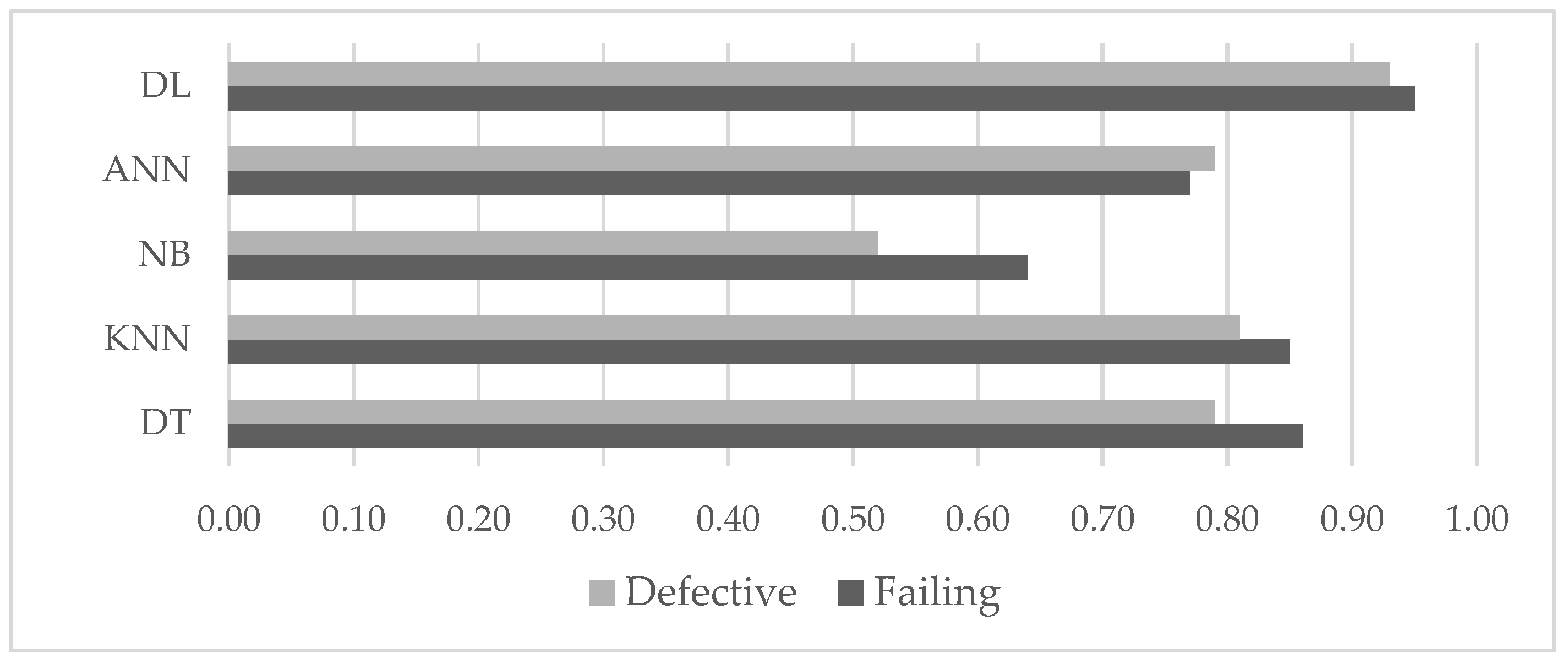
| Aspect | Sensor and Factor | Description |
|---|---|---|
| Outdoor environment | Outdoor (1) temperature and (2) humidity, assigned by the universe, using AM2315. | They are critical factors ruled by the universe that affect human comforts. |
| Indoor environment | Indoor (3) temperature and (4) humidity affecting human comfort, using DHT22. | According to outdoor environments, these are directly changed over time, i.e., converging. |
| HVAC system | (5) Electric current consumed by HVAC system engines, using SCT-013. | This is a primary key indicating the status of the HVAC system engine. |
| Timestamp | (6) Time of event occurring, produced by ESP32. | Time period is an essential factor indicating HVAC system behaviors. |
| System behavior | The functioning status of the HVAC system engine (e.g., inactive, normal, defective, or failing). | This requires the above factors in order to determine system behaviors (labeled by technicians and engineers). |
| Model | DT | KNN | NB | ANN | DL | ||||||||||
|---|---|---|---|---|---|---|---|---|---|---|---|---|---|---|---|
| Class\Matrices | PS | RC | F1 | PS | RC | F1 | PS | RC | F1 | PS | RC | F1 | PS | RC | F1 |
| Inactive | 0.97 | 0.95 | 0.96 | 0.95 | 0.96 | 0.96 | 0.60 | 0.77 | 0.68 | 1.00 | 1.00 | 1.00 | 1.00 | 1.00 | 1.00 |
| Failing | 0.87 | 0.85 | 0.86 | 0.88 | 0.82 | 0.85 | 0.81 | 0.54 | 0.64 | 0.78 | 0.78 | 0.77 | 0.90 | 1.00 | 0.95 |
| Defective | 0.78 | 0.81 | 0.79 | 0.81 | 0.80 | 0.81 | 0.41 | 0.69 | 0.52 | 0.81 | 0.76 | 0.79 | 0.93 | 0.92 | 0.93 |
| Normal | 0.89 | 0.90 | 0.90 | 0.90 | 0.90 | 0.90 | 0.44 | 0.19 | 0.27 | 0.91 | 0.92 | 0.91 | 1.00 | 0.97 | 0.98 |
| Average | 0.88 | 0.88 | 0.88 | 0.89 | 0.87 | 0.88 | 0.57 | 0.55 | 0.53 | 0.88 | 0.87 | 0.87 | 0.96 | 0.97 | 0.97 |
| Accuracy | 0.90 | 0.90 | 0.53 | 0.92 | 0.95 | ||||||||||
Disclaimer/Publisher’s Note: The statements, opinions and data contained in all publications are solely those of the individual author(s) and contributor(s) and not of MDPI and/or the editor(s). MDPI and/or the editor(s) disclaim responsibility for any injury to people or property resulting from any ideas, methods, instructions or products referred to in the content. |
© 2022 by the authors. Licensee MDPI, Basel, Switzerland. This article is an open access article distributed under the terms and conditions of the Creative Commons Attribution (CC BY) license (https://creativecommons.org/licenses/by/4.0/).
Share and Cite
Haruehansapong, K.; Roungprom, W.; Kliangkhlao, M.; Yeranee, K.; Sahoh, B. Deep Learning-Driven Automated Fault Detection and Diagnostics Based on a Contextual Environment: A Case Study of HVAC System. Buildings 2023, 13, 27. https://doi.org/10.3390/buildings13010027
Haruehansapong K, Roungprom W, Kliangkhlao M, Yeranee K, Sahoh B. Deep Learning-Driven Automated Fault Detection and Diagnostics Based on a Contextual Environment: A Case Study of HVAC System. Buildings. 2023; 13(1):27. https://doi.org/10.3390/buildings13010027
Chicago/Turabian StyleHaruehansapong, Kanjana, Wisit Roungprom, Mallika Kliangkhlao, Kirttayoth Yeranee, and Bukhoree Sahoh. 2023. "Deep Learning-Driven Automated Fault Detection and Diagnostics Based on a Contextual Environment: A Case Study of HVAC System" Buildings 13, no. 1: 27. https://doi.org/10.3390/buildings13010027
APA StyleHaruehansapong, K., Roungprom, W., Kliangkhlao, M., Yeranee, K., & Sahoh, B. (2023). Deep Learning-Driven Automated Fault Detection and Diagnostics Based on a Contextual Environment: A Case Study of HVAC System. Buildings, 13(1), 27. https://doi.org/10.3390/buildings13010027








